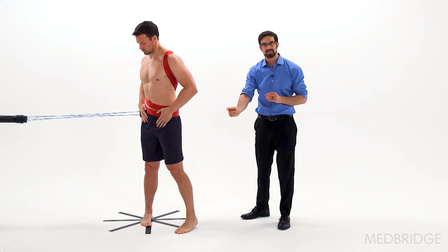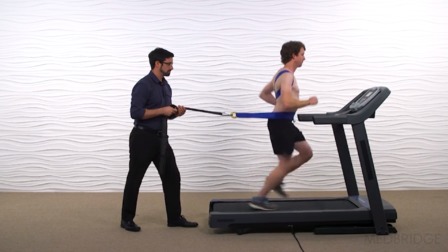This continuing education course is hosted on the Medbridge platform and teaches you how to use the movement system to assess, diagnose, and treat athlete movement dysfunction. The course is highly interactive. After analyzing human movement, you will integrate concepts of mobility, muscle performance, and symptom modification procedures into movement-based classifications. You will learn how to develop interventions based on observed faulty movement patterns and integrate sport-specific treatments into a systematic framework that addresses the athlete's spine.
-
 This course will utilize the movement system as a framework to assess the biomechanics of tennis. You will learn how to identify the critical events of the tennis serve, forehand, and backhand. You will then advance your movement assessment skills by integrating specific assessment techniques that correlate with each critical event. Based on your movement observations and biomechanics knowledge, you will then learn how to classify movement dysfunction and provide sport-specific treatments to correct inefficient movement.
This course will utilize the movement system as a framework to assess the biomechanics of tennis. You will learn how to identify the critical events of the tennis serve, forehand, and backhand. You will then advance your movement assessment skills by integrating specific assessment techniques that correlate with each critical event. Based on your movement observations and biomechanics knowledge, you will then learn how to classify movement dysfunction and provide sport-specific treatments to correct inefficient movement. -
 This continuing education course is hosted on the Medbridge platform. It will utilize the movement system as a framework to assess the biomechanics of throwing. You will learn how to classify scapular, humeral, and thoracic movement patterns as they relate to observation range of motion. You will then advance your movement assessment skills by learning the biomechanics and critical events of a throw. Based on your movement observations and biomechanics knowledge, you will then learn how to classify movement dysfunction and provide sport-specific treatments to correct inefficient movement.
This continuing education course is hosted on the Medbridge platform. It will utilize the movement system as a framework to assess the biomechanics of throwing. You will learn how to classify scapular, humeral, and thoracic movement patterns as they relate to observation range of motion. You will then advance your movement assessment skills by learning the biomechanics and critical events of a throw. Based on your movement observations and biomechanics knowledge, you will then learn how to classify movement dysfunction and provide sport-specific treatments to correct inefficient movement. -
 This course is a recording of a previously hosted live webinar event. Polling and question submission features are not available for this recording. Format and structure may differ from standard MedBridge courses. This course teaches you how to use the movement system to assess, diagnose and treat athlete movement dysfunction. The material is highly interactive with an emphasis on the practical application of principles covered in the course. Concepts utilized in the course include symptom modification procedures, dynamometry, anatomical slings, neuromuscular chains, dual vectors and reflexive activation.nt.
This course is a recording of a previously hosted live webinar event. Polling and question submission features are not available for this recording. Format and structure may differ from standard MedBridge courses. This course teaches you how to use the movement system to assess, diagnose and treat athlete movement dysfunction. The material is highly interactive with an emphasis on the practical application of principles covered in the course. Concepts utilized in the course include symptom modification procedures, dynamometry, anatomical slings, neuromuscular chains, dual vectors and reflexive activation.nt. -
 This continuing education course is a recorded webinar hosted on the Medbridge platform. This course incorporates biomechanical, movement, and sport-specific based assessments to analyze and treat the lower quarter athlete. Concepts utilized in the course include relative flexibility, quality and timing of muscle contraction, dynamometry, closed kinetic chain muscle testing, speed of force generation, cross-body assessments, anatomical slings, neuromuscular chains, dual vectors, and reflexive activation. After the course, you will have a greater understanding of how to integrate clinical movement-based assessments into sport-specific treatments.
This continuing education course is a recorded webinar hosted on the Medbridge platform. This course incorporates biomechanical, movement, and sport-specific based assessments to analyze and treat the lower quarter athlete. Concepts utilized in the course include relative flexibility, quality and timing of muscle contraction, dynamometry, closed kinetic chain muscle testing, speed of force generation, cross-body assessments, anatomical slings, neuromuscular chains, dual vectors, and reflexive activation. After the course, you will have a greater understanding of how to integrate clinical movement-based assessments into sport-specific treatments. -
 This continuing education course is hosted on the Medbridge platform. It will utilize the movement system as a framework to assess the biomechanics of swimming. You will learn how to analyze the four common swim strokes: freestyle, butterfly, breaststroke, and backstroke. You will then advance your movement assessment skills by learning how to integrate swim stroke assessment in the clinical environment. Based on your movement observations and biomechanics knowledge, you will then learn how to classify movement dysfunction and provide swim-specific treatments to correct inefficient movement.
This continuing education course is hosted on the Medbridge platform. It will utilize the movement system as a framework to assess the biomechanics of swimming. You will learn how to analyze the four common swim strokes: freestyle, butterfly, breaststroke, and backstroke. You will then advance your movement assessment skills by learning how to integrate swim stroke assessment in the clinical environment. Based on your movement observations and biomechanics knowledge, you will then learn how to classify movement dysfunction and provide swim-specific treatments to correct inefficient movement. -
 This continuing education course is hosted on the Medbridge platform. It will utilize the movement system as a framework to assess the biomechanics of throwing. You will learn how to classify scapular, humeral, and thoracic movement patterns as they relate to observation range of motion. You will then advance your movement assessment skills by learning the biomechanics and critical events of a throw. Based on your movement observations and biomechanics knowledge, you will then learn how to classify movement dysfunction and provide sport-specific treatments to correct inefficient movement.
This continuing education course is hosted on the Medbridge platform. It will utilize the movement system as a framework to assess the biomechanics of throwing. You will learn how to classify scapular, humeral, and thoracic movement patterns as they relate to observation range of motion. You will then advance your movement assessment skills by learning the biomechanics and critical events of a throw. Based on your movement observations and biomechanics knowledge, you will then learn how to classify movement dysfunction and provide sport-specific treatments to correct inefficient movement. -
 Use this code to receive a discounted rate : TheClimbingDoc This continuing education course is hosted on the Medbridge platform. It will utilize the movement system as a framework to assess the biomechanics of throwing. You will learn how to classify scapular, humeral, and thoracic movement patterns as they relate to observation range of motion. You will then advance your movement assessment skills by learning the biomechanics and critical events of a throw. Based on your movement observations and biomechanics knowledge, you will then learn how to classify movement dysfunction and provide sport-specific treatments to correct inefficient movement.
Use this code to receive a discounted rate : TheClimbingDoc This continuing education course is hosted on the Medbridge platform. It will utilize the movement system as a framework to assess the biomechanics of throwing. You will learn how to classify scapular, humeral, and thoracic movement patterns as they relate to observation range of motion. You will then advance your movement assessment skills by learning the biomechanics and critical events of a throw. Based on your movement observations and biomechanics knowledge, you will then learn how to classify movement dysfunction and provide sport-specific treatments to correct inefficient movement.

